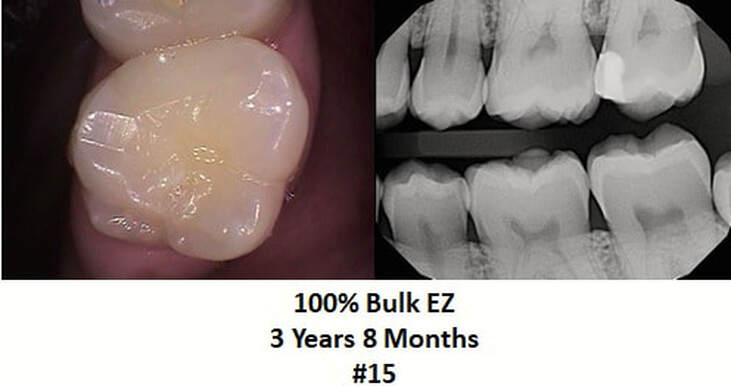Issue 34, November 2020
Dear Fellow Bondodontists,
With the current COVID situation, we have been doing some webinars this year. I try to announce them to our Fifth Quarter Seminars data base. In case that you have not received notice, most likely we do not have your current e-mail address. Just let me know and I will make sure to get your info corrected. Best contact: rbertolott@aol.com
We do have a booking for Yosemite 2021 on October 28-30. Let's all hope that we are able to do a live event. We will announce the program after the first of the year. Tentatively it features two of my favorite speakers, Geoff Knight and Prof. Eddie Lynch. Most likely I will serve as Moderator.
All current seminars and webinars are listed on the Seminars page.
Let’s look forward to a COVID free time ahead.
Stay Bonded,
Ray
Bulkfills
Polymerization shrinkage is the enemy.
In my opinion, bulkfill composite never made sense. Composite is not white amalgam! In all composite, polymerization shrinkage is the enemy. So what if composite has “low shrinkage”? Shrinkage is shrinkage and bacteria which get in the resulting gaps are very small. Typical gaps are way larger than bacteria. For assured success, the tooth bond to composite interface must be sealed, no gap. FYI, low shrinkage in composite is usually accompanied by high modulus, effectively negating any benefit of the reduced shrinkage. The resulting high shrinkage stress tends to break the bond to the tooth, leading to a gap or white line when on enamel.
Well, there is a major development. That is initiating polymerization at the bond, effectively causing the polymerization shrinkage of the bulkfill to be directed toward the tooth. The result is no gap between the composite filling and the tooth. Naturally you might ask how this is possible after all these years. I am discussing this concept in current webinars but to make a long story very short. It is the genius of Dr. Sean Chen who devised a new polymerization chemistry to initiate a cascade of polymerization beginning at the bonding agent, which then progresses into the composite, effectively pulling composite toward the bond..
There is independent confirmation of the concept from two very highly respected researchers: Prof. Alireza Sadr at the University of Washington who uses optical coherence tomography (OCT) and Prof. Nate Lawson at the University of Alabama who uses more conventional microscopic techniques.
Here are some of Prof. Sadr's images: Two very popular bulkfills, SDR is shown first, Sonicfill next, then the revolutionary material, Bulk EZ. You can easily see the gap on the pulpal floor in the first two but the Bulk EZ shows no gap, in this severe C-factor class I filling. Say Goodbye to post-op bite pressure sensitivity and to "recurrent" caries at the gingival margin. Also you will see remarkably stain free margins and absence of white lines (See more below).
Surefill SDR
Sonicfill
Bulk EZ
These images are screen shots taken from a video which you can view: http://depts.washington.edu/b4t/jdr-appendix/
This video is amazing. “Video D” is Bulk EZ and you can see its shrinkage occurring in slow motion, like you have x-ray vision. Just compare its shrinkage to the other bulk fills and you will better understand the "no gap" that I have been talking about. FYI, due to the configuration of the OCT probe, the video images are upside down. As you can see, “Bulk fills work very well until you turn the curing light on. Exception, Bulk EZ.”
This discussion reminds me of what Prof. Junji Tagami said last year at Yosemite: “Bulk fills work well when incrementally placed”.
Of special interest to many of my seminar friends is Clearfil Photo Core in Prof. Sadr's video. It is not gap free but close and clearly better than the bulkfills other than Bulk EZ. Clearfil Photo Core is a light cure core material that might not be expected to work well but we know that is does. The manufacturer says it will light cure 5 mm depth but that is not correct. In an ISO 4049 test, we measured over 9 mm. No wonder it has been so successful for all these years since we began using it in 1986.
Further confirming the above results, from Prof. Lawson at the University of Alabama:
This video is amazing. “Video D” is Bulk EZ and you can see its shrinkage occurring in slow motion, like you have x-ray vision. Just compare its shrinkage to the other bulk fills and you will better understand the "no gap" that I have been talking about. FYI, due to the configuration of the OCT probe, the video images are upside down. As you can see, “Bulk fills work very well until you turn the curing light on. Exception, Bulk EZ.”
This discussion reminds me of what Prof. Junji Tagami said last year at Yosemite: “Bulk fills work well when incrementally placed”.
Of special interest to many of my seminar friends is Clearfil Photo Core in Prof. Sadr's video. It is not gap free but close and clearly better than the bulkfills other than Bulk EZ. Clearfil Photo Core is a light cure core material that might not be expected to work well but we know that is does. The manufacturer says it will light cure 5 mm depth but that is not correct. In an ISO 4049 test, we measured over 9 mm. No wonder it has been so successful for all these years since we began using it in 1986.
Further confirming the above results, from Prof. Lawson at the University of Alabama:
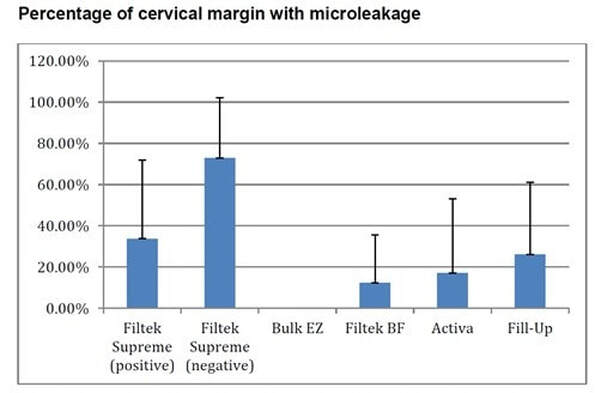
Note that only Bulk EZ was the only material which had no cervical margin
microleakage (no gap). The other bulkfill product tested is 3M Filtek BF.
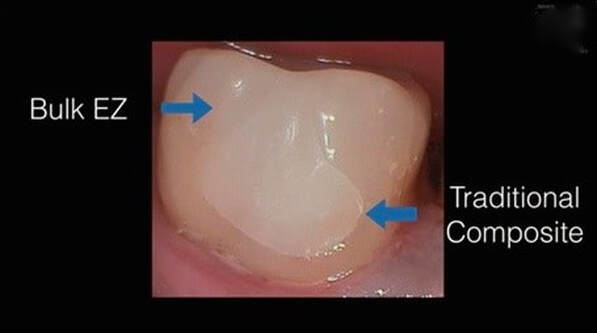
Here is a nice clinical comparison of Bulk EZ and a flowable composite placed in contact with enamel, courtesy of Mike Nelson DDS. Mike placed an occlusal-buccal composite restoration but underfilled the buccal surface inside the matrix. After removing the matrix, he injected some light curing flowable to fill the void. After light curing, you can see a big margin difference. Wow!
There is no “white line” adjacent to the Bulk EZ like there is around the flowable. This is great proof of both no gap and stress reduction, as evidenced by lack of white line with Bulk EZ.
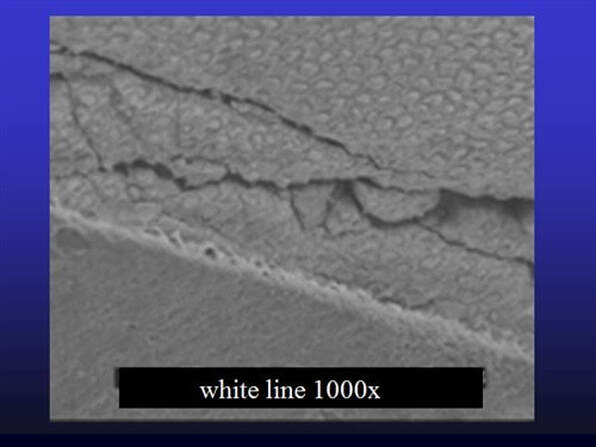
In a microscope, the white line at the flowable composite to enamel junction is easily seen. It is a zone of microfracture of the enamel, caused by polymerization stress. With Bulk EZ, there is no white line due to lower polymerization stress, insufficient to fracture the enamel.
So how does this all affect the critical gingival margin on a class II composite? Here is a comparison of Bulk EZ and Sonicfill in a laboratory test. Testing was done by thermal cycling in water, using a stain to mark leakage.
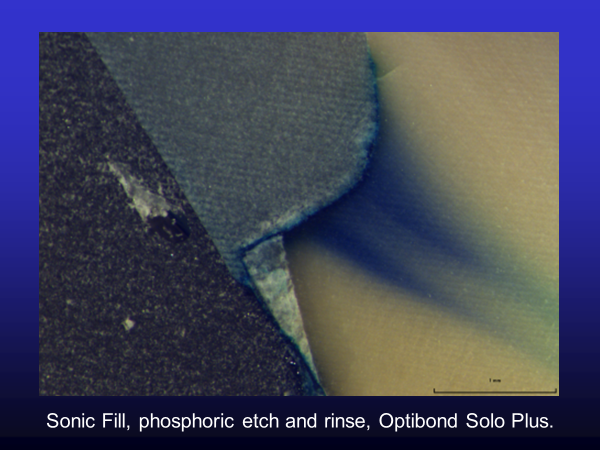
Sonicfill
The leakage that we can easily see after thermal cycling is quite remarkable.
The gingival margin was on phosphoric acid etched enamel. Kerr's instructions
say that any bonding agent can can used with Sonicfill so we used Optibond
Solo Plus, Kerr's largest seller.
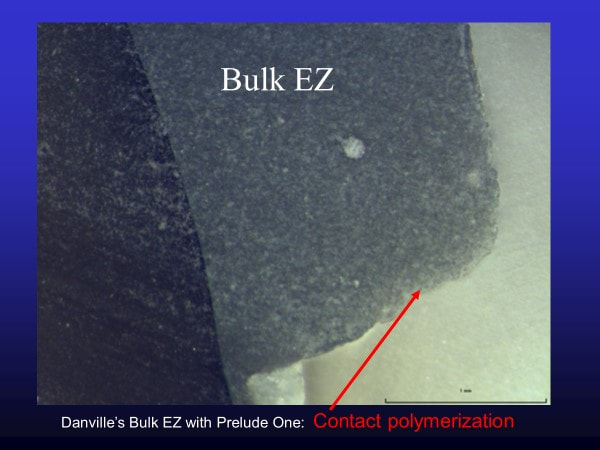
Bulk EZ
The result for Bulk EZ is remarkably different. No leakage is evident. Danville's instructions say that any methacrylate bonding agent may be be used. (This means just about any bonding agent, excepting glass ionomer based ones.) We used Danville's Prelude One and it worked very well.
The Bulk EZ Instructions for Use give the option to place a layer of normal light curing composite over the Bulk EZ when used in posterior restorations. That recommendation was made since initially it was not known know how well the Bulk EZ would resist wear. Our laboratory testing indicated that it would compare to Herculite for wear. Our test was wrong! In the mouth it is way better than Herculite. It stays polished well and the margin integrity (not easily tested in the lab) can’t be beat.
Here is a nice clinical result provided by Mike Nelson DDS.
It is clear that Bulk EZ is a game changer. I very highly recommend this product. All Danville/Zest dealers should have it in stock but I usually recommend Tin Man Dental for their product knowledge, advice and great customer service.



